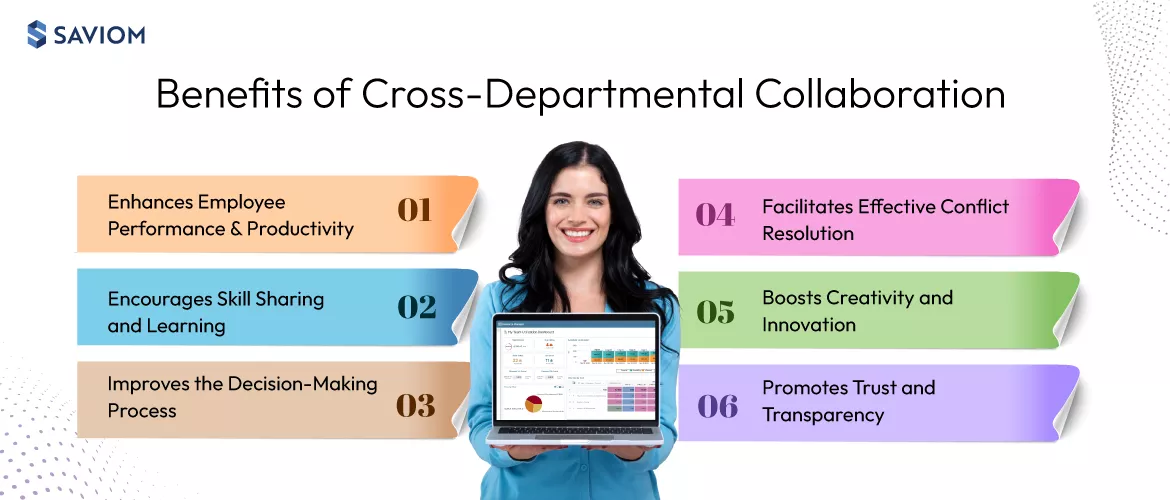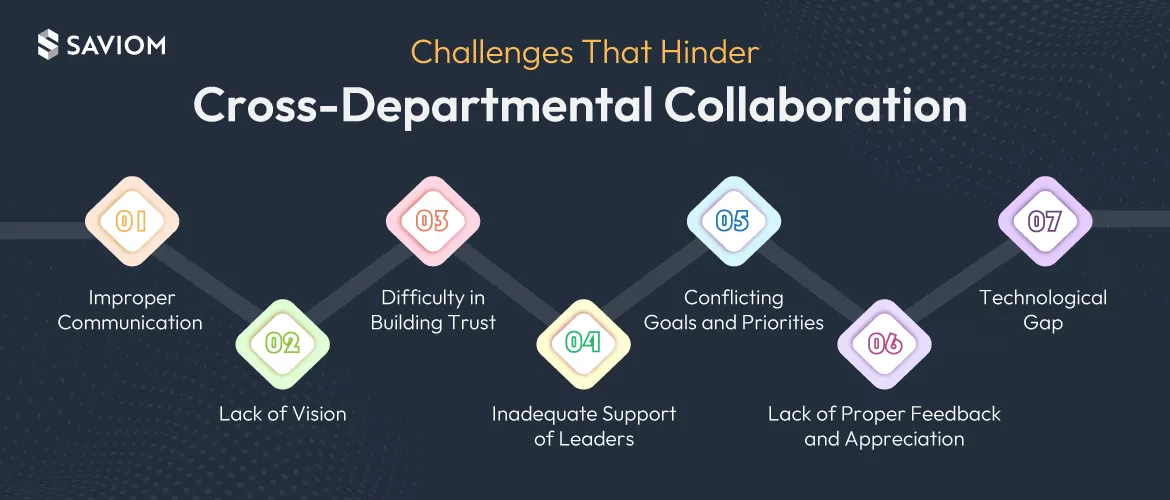Cross-departmental collaboration has emerged as a crucial factor in driving innovation, operational efficiency, and overall organizational success. Imagine a symphony orchestra where each section plays its own melody without regard for the others – the result would be chaos. Similarly, when departments within a company operate in silos, the outcome is often poor results and missed business opportunities.
Therefore, it’s safe to say that cross-departmental collaboration is undoubtedly an integral part of an efficient and thriving work environment.
However, amid the pressure of meeting strict deadlines, team members sometimes overlook the importance of communicating critical information. Some departments even go as far as to treat work as a competition to reach the finish line. However, prioritizing competition over cross-team collaboration can significantly hinder project outcomes and business success. That’s why firms must take proactive measures to break down organizational silos and foster a collaborative workplace.
This article elucidates the importance of cross-departmental collaboration and key strategies to improve it.
But first, let us understand the definition of cross-departmental collaboration.
What is Cross-Departmental Collaboration?
Cross-departmental collaboration, also known as cross-functional collaboration, refers to the structured cooperation between individuals or teams across departments working together to achieve a common organizational goal. It promotes collective problem-solving, aligns diverse expertise, and improves overall business efficiency.
This kind of collaboration between teams involves sharing knowledge, resources, and expertise between various departments. Thus, cross departmental communication helps firms drive creative problem-solving, boosts overall performance, and ensures better business outcomes.
Let’s go through an example for cross-departmental collaboration.
Example of Cross-Departmental Team Collaboration
Consider a scenario where a company is working on a new product launch. This project will require input and collaboration from various teams across the organization, including business strategy, research & development, product design, engineering, marketing, sales, and customer service.
Here’s how it works –
- First, the business strategy and the R&D teams would conduct preliminary market research to understand customer pain points, assess the feasibility of the new product, and create a product roadmap.
- Then, the design team would create the blueprint of the physical or digital product, and the engineering department would work on its execution.
- In addition, the marketing team would create campaigns to raise awareness about the upcoming product launch.
- Now, the sales department will develop customer personas and, accordingly, create appropriate pricing strategies.
- And finally, the customer service department will ensure that end users have a positive experience after purchase.
Thus, for a successful product launch, all the departments must work cohesively like cogs in a wheel. Each of their contributions, no matter how small or big, has a significant impact on overall product delivery. Hence, effective cross-departmental collaboration helps ensure that the final product meets the needs of both the business and its customers.
Now, let’s understand the significance of cross-departmental collaboration.
Benefits of Cross-Departmental Collaboration
Facilitating cross-departmental collaboration brings numerous benefits for firms. Some of them are as follows –
Enhances Employee Performance and Productivity
Interdepartmental teamwork can lead to increased knowledge sharing and skill development among employees. When individuals from different areas coordinate, they often learn from each other and gain insights & expertise that can improve their work performance. This exchange of knowledge can also lead to increased efficiency and employee productivity in completing tasks.
Encourages Skill Sharing and Learning
While collaborating across functional units, employees can engage in job shadowing, peer-to-peer training, or inter-departmental learning workshops that expose them to new tools, decision-making frameworks, or problem-solving approaches. This cross-departmental collaboration not only diversifies their skill sets but also builds a more agile, future-ready workforce that can take on multi-functional roles when needed.
Read More: What is Skill Development? 10 Best Strategies to Build a Future-Ready Workforce
Improves the Decision-Making Process
Collaborating across departments brings different perspectives to the table. This diversity of viewpoints can lead to more well-rounded and informed decision-making. Teams that draw on insights from multiple areas of the organization are better equipped to identify potential risks and opportunities and make strategic decisions that align with the overall goals of the company.
Facilitates Effective Conflict Resolution
Conflicts and disagreements can arise in any organization, but cross-departmental collaboration can provide a platform for resolving them more effectively. When individuals from different departments work together, they are often exposed to different working styles and priorities. This exposure can help team members develop conflict-resolution skills and find mutually beneficial solutions.
Read More: Top 24 People Skills Every Professional Needs to be Successful
Boosts Creativity and Innovation
Innovation often thrives at the intersection of different disciplines and perspectives. When employees from various departments collaborate, they bring diverse ideas, experiences, and approaches to problem-solving. This diversity of thought can spark creativity and lead to innovative solutions and new product/service offerings.
Promotes Trust and Transparency
Cross-departmental collaboration promotes a culture of trust and transparency within an organization. When employees from different areas work together, they gain a better understanding of each other’s roles and responsibilities, which can reduce misunderstandings and foster trust. Additionally, sharing information and insights across departments can lead to a more open and transparent organizational culture.
Read More: How Can Your Work Culture Improve the Employee Experience?

In the following section, we’ll go through the key elements of cross-functional teams.
Key Elements of Collaborative Team
Cross-functional teams are essential in any work environment, and they can greatly contribute to the project’s success and the achievement of organizational goals.
Here are the key elements of cross-functional teams.
Autonomy
Autonomy refers to the ability of team members to make decisions and take actions independently, within the scope of their responsibilities. This means trusting team members to work on their tasks without constant micromanagement. Thus, it allows individuals to showcase their expertise and take ownership of their work, which can lead to increased motivation and better results.
Cooperation
Cooperation is the foundation of collaborative teams. It involves team members working together towards a common goal. This means sharing information, resources, and ideas, and being willing to help one another. Effective cooperation can lead to a synergy where the collective output is greater than the sum of individual contributions.
Mutual Trust & Respect
Trust and respect are crucial for a collaborative team to function effectively. Team members need to trust that their colleagues will deliver on their commitments and respect each other’s opinions and contributions. This will help create a positive work environment, reduce conflicts, and foster better cross-departmental collaboration.
Read More: How to Foster Trust and Transparency in Remote Teams
Accountability
Accountability ensures that team members are responsible for their actions, commitments, and outcomes. When team members are held accountable for their work, it promotes a sense of ownership and ensures that tasks are completed on time and to the required quality standards.
Communication
Effective communication is the glue that holds a collaborative team together. It involves both verbal and non-verbal interactions, as well as active listening. Clear and open communication will ensure that team members are on the same page, understand each other’s needs and concerns, and can coordinate their efforts effectively.
Problem- Solving
A collaborative team always provides a broader lens to approach challenges, as they don’t tackle an issue in isolation. Multiple viewpoints help uncover root causes faster and bring creative fixes to light. It also reduces blame-shifting since the focus stays on resolving the problem together rather than on who caused it.
Knowing the key elements of cross-functional teams’ collaboration, let’s investigate some challenges hindering effective cross-departmental collaboration.
Common Challenges That Hinder Cross-Departmental Collaboration
Successful cross-departmental collaboration in the workplace positively influences the company, business, or project. However, there are specific roadblocks that make it difficult for teams to work cohesively. Listed below are a few:
Improper Communication
A survey by Forbes Advisor cites that “lack of effective communication impacted cross-functional collaboration for 42% of respondents.”
When organizations fail to foster open communication in the workplace, team collaboration suffers. It reduces cross-team engagement across various activities. This leads to poor information transfer, internal conflicts, and project delays, ultimately risking project failure.
Lack of Vision
When firms lack clear goals, teams work without purpose. This ambiguity in roles and responsibilities not only diminishes employee productivity, efficiency, and motivation but also hinders managers’ ability to delegate tasks effectively, as they cannot prioritize work. As a result, this causes resource wastage and project failures.
Difficulty in Building Trust
Trust, an essential aspect of cross-departmental collaboration, cannot be developed without adequate coordination between team members. When trust is lacking, teams are less likely to share information freely or work together effectively. This can lead to misunderstandings, conflicts, and inefficiencies.
Inadequate Support of Leaders
Leadership plays a pivotal role in promoting and sustaining cross-departmental collaboration. When leaders fail to prioritize or actively support collaborative initiatives, teams may lack the necessary guidance, resources, or motivation to work together effectively.
Conflicting Goals and Priorities
Departments often have their own goals and priorities, which may not always align with the goals of other departments or the organization as a whole. When there is a lack of alignment, it can lead to competition for resources and a reluctance to cooperate.
Read More: How to Ensure Effective Conflict Resolution in a Hybrid Office?
Lack of Proper Feedback and Appreciation
According to PwC, “51% of millennials prefer frequent, detailed feedback on their work.”
Organizations that do not encourage their employees with regular, detailed feedback and appreciation will see a dip in productivity and performance. In addition, when employees’ efforts and contributions are not recognized, it may lead to demotivation and disengagement in the workplace.
Technological Gap
As per a report by Robert Half 2025, “48% of job seekers preferred a hybrid role while 26% of them desired a remote job.”
The rise in work-from-home and remote working arrangements has increFased the need for advanced technologies. Here, a technological deficiency can impede seamless cross-departmental collaboration among remote and hybrid workforces, leading to miscommunication, internal conflicts, and delivery delays.

Owing to the challenges mentioned above, managers should strive to improve collaboration between teams. Next, let’s discuss some strategies that help promote cross-functional collaboration.
10 Strategies to Improve Collaboration Between Departments
To successfully run a business, firms must ensure effective collaboration between individuals, teams, and departments. Here are some best practices to improve your internal, cross-departmental collaboration.
Convey the Ultimate Goal and Vision with Transparency
One of the most critical responsibilities of a decision-maker is to convey the firm’s goals and objectives with the utmost transparency. If you expect your cross-functional team to work cohesively, you must periodically educate them about the goals and vision.
When your workforce is aware of how their work adds value, they are more likely to take the initiative. This will gradually increase communication, improve cross-departmental collaboration, and maintain the flow of data.
Gain an Enterprise-wide Visibility of Resources
Effective inter-departmental coordination can only happen when everyone in the team is on the same page, or it may lead to unnecessary conflicts. To do so, managers can deploy a resource management tool in the organization.
It will provide them with a bird’s eye view of the project resources and their attributes, such as skills, competencies, availability, location, cost rate, etc. With this, managers can assign the right task to the right person. Moreover, teams will know the project’s progress and can work more efficiently to achieve the end goal.
Understand the Task Interdependencies
Employees must make a concerted effort to understand task interdependencies to facilitate better delivery. When individuals grasp how their work impacts others, they can align their efforts and anticipate potential challenges that may arise at later stages. This proactive approach enhances cross-departmental collaboration, leading to successful project outcomes.
For instance, if you are working on content development, understanding how your input influences the design team allows you to provide them with timely deliverables and helpful feedback. This collaboration ensures that design and content complement each other.
Read More: What are Project Interdependencies & How to Manage them Effectively?
Initiate Joint Projects Between Departments
The next step after understanding the interdependencies is to take up more projects that involve cross-functional coordination. More so, when resources collaborate with other departments, it will help them communicate better. They can then readily solve complex issues together.
For example, they can initiate cross-functional task forces for specific projects, organize joint workshops, or set up regular interdepartmental meetings to discuss and share insights. These initiatives foster better understanding, cooperation, and problem-solving across teams.
Provide Executive & Management Support
Employees look up to their higher-ups in the organization to lead by example. When the firm’s top executives invest time and effort in building social relationships, it becomes the DNA of the company culture. Therefore, it is essential for executives to demonstrate collaborative and interactive behaviour to ensure it is followed throughout the firm.
For example, executives can regularly engage in open-door policies for better accessibility and actively involve themselves in team-building activities. Additionally, they can host company-wide forums or Q&A sessions to encourage transparency and direct communication. Such actions help foster a culture of collaboration and interaction.
Establish Communication Methods and Channels
According to WorkTalk, “poor communication resulted in an estimated loss of $37 billion among employees in over 400 large U.S. and U.K. companies.”
Encouraging effective communication between departments is only half the battle won. The real task is standardizing communication procedures and helping everyone know when and how to communicate. Before the project’s onset, managers must define the communication channels and processes to be followed to ensure profitable outcomes.
This includes,
- Specifying when to use the synchronous or asynchronous mode of communication.
- Communication etiquette is to be followed by the resources when engaging in cross-functional communication.
- Team collaboration tools or apps should be equipped to allow the smooth exchange of information.
- Concerned authority to be addressed and contacted in case of any pressing matter or escalation.
Share and Exchange Feedback Among Everyone
There is always room for improvement, whether you are an executive or working at a junior level. To help your employees improve, project managers can connect with different department heads to hold project closure meetings. These meetings will help everyone share and exchange feedback.
Decision-makers will know from employees if the process needs to be improved, and employees will know the areas they need to work on.
Establishing a two-way feedback mechanism will encourage cross-functional team collaboration and give everyone a fair chance to grow professionally.
Read More: 7 Proven Ways to Give Constructive Feedback to Your Employees
Train the Staff for the Right Skillset
You may encounter a situation where you have already established a communicative company culture, but some team members still lack those habits that can help them merge. So, managers can initiate training programs to fill these skill gaps and make a notable difference in team performance.
A classic example of the firm that initiated such programs is Pricewaterhouse Coopers. Their training modules include teamwork, emotional Intelligence, and networking. They also train employees to communicate the firm’s strategy and build healthy partnerships. Including such modules in your training program and honing your workforce’s soft skills will improve cross-functional collaboration at work and give an added advantage.
Read More: Top 7 Business Benefits of Training Scheduling Software
Implement Rewards and Recognition Program
According to Quantum Workspace, “employees are 2.7 times more likely to be highly engaged when they know their efforts will be recognized”.
Resources help you meet the project deadlines with all their might and capabilities. It is needless to say that their work and effort deserve acknowledgment. Project managers and executives can integrate rewards and recognition programs into their workplace policies to acknowledge hard work.
This step will encourage effective team collaboration with the higher-ups and colleagues. For example, they can start a “Team Player of the Month” award, offer performance-based bonuses, or organize appreciation events. These initiatives motivate employees and enhance job satisfaction.
Read More: Employee Recognition Programs: Types, Benefits, and Best Practices
Organize Various Team-Building Activities
All work, no play, is a recipe for low productivity and disengagement. If your team is only communicating formally during meetings or project discussions, then the human element is missing from the equation. To get this right, department managers can collaborate and cooperate in organizing various team-building activities.
For example, they can conduct workshops focused on improving communication skills, organize team outings to build camaraderie, and host collaborative problem-solving exercises. These activities are beneficial for understanding everyone’s strengths and weaknesses and acting accordingly. Moreover, it is always healthy to have some fun at the workplace along with work.
You can use these ways to improve cross-departmental collaboration at your firm. Now, let’s read how an advanced resource management solution can help.
How Does a 5th Gen Resource Management Software Help Improve Cross-Departmental Collaboration?
A modern resource management tool offers numerous functionalities that help improve cross-departmental collaboration. Here are a few:
- The all-in-one resource planner offers a multi-dimensional analysis feature that allows managers to view resources across departments by skills, roles, availability, and more. This breaking down of silos makes cross-team coordination smooth and structured.
- The intelligent matchmaking feature helps managers identify suitable resources across departments, facilitating the creation of well-balanced, cross-functional project teams.
- Next, the tool’s embedded heat map feature gives visibility into utilization across departments, helping redistribute workloads, i.e., avoid overloading some members while others remain idle for better team dynamics.
- The task management feature displays start and end dates of tasks, making it easier to sync timelines and dependencies across teams from different departments.
- Using the tool’s business intelligence capabilities, stakeholders can access department-wise resource data, track performance trends, and make informed decisions, fostering transparency and collaboration.
- The software’s integrated collaboration platform enables teams to communicate and share files, messages, and project updates seamlessly, ensuring smooth operations and better productivity.
Conclusion
The late American business magnate Steve Jobs once said, “One person never does great things in business.”
This adage holds true in every sense. One cannot accomplish projects and reach milestones without the help of others.
Cross-departmental collaboration is, therefore, a key to a business’s success.
Implementing the above strategies, coupled with modern resource management software, will help firms improve and maintain effective collaboration between departments. In addition, it will also enhance productivity and engagement of employees, improve project success rate, and maximize profitability.
What ways do you follow to foster cross-departmental collaboration at your company?
The Glossary
Read More: Glossary of Resource Workforce Planning, Scheduling and Management












Leave a Reply